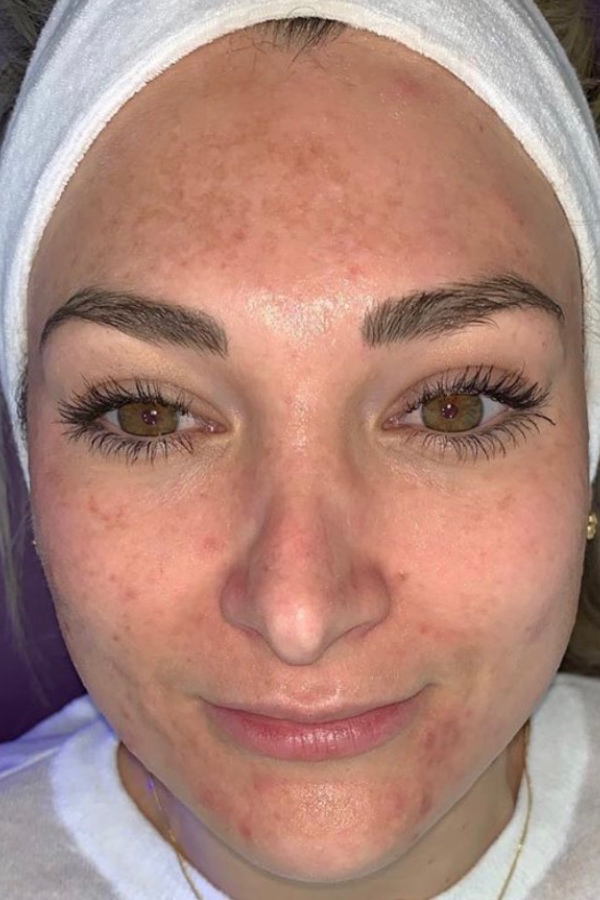We investigate cosmelan®, a treatment that’s helping banish visible pigmentation for good.
Freckles. Brown patches. Sun spots. Sound familiar? You’re not alone – as many as 80% of us suffer some sort of pigmentation skin disorder. Skin hyperpigmentation is caused by the abnormal production of melanin, the pigment responsible for skin colour, and is a consequence of uncontrolled, localised overproduction of melanin by the melanocytes, causing irregular skin discolouration and dark spots. It can be triggered by a number of factors, including exposure to sunlight, hormonal changes, skin inflammation or injury, and genetic predisposition.
If you suffer from hyperpigmentation, chances are you’ve already tried every trick in the book – including all the lotions and potions with lofty claims that they can brighten skin. The reality is that hyperpigmentation is frustratingly resistant to treatment.
That’s why cosmelan® depigmentation professional treatment is being hailed as a breakthrough in treating hyperpigmentation disorders. The advanced formulation from the multinational mesoestetic® Pharma Group which specialises in medical cosmetics, offers a relatively simple in-clinic solution and home system for these traditionally hard-to-treat skin concerns.
‘We’ve been using cosmelan® in the clinic since August 2019 and it has become our most widely performed and requested treatment due to its high clearance success rate,’ says Savanah Desiree Lee, Director at Sydney Dermal Lounge. ‘It can be used on all types of pigmentation and on all skin types.’
‘As a clinic which specialises in the correction of hyperpigmentation, we will only perform treatments that have minimal risk and offer a true solution. cosmelan® is the hero in our depigmentation treatments. When performed alongside both in-clinic preparation and clinical support, the first stages of clearance, following the application of the mask, is often seen in as little as two weeks. The results speak for themselves: remarkable and in some cases life-changing.’
What is cosmelan®?
cosmelan® by mesoestetic® is the world’s leading professional depigmentation method, designed to help reduce the appearance of dark spots on your skin, while visibly enhancing skin tone, smoothness and luminosity.
‘cosmelan® is used as a brightening method, helping to achieve short and long-term results by keeping hyperpigmentation under control.’ explains Savanah.
‘cosmelan® has the ability to make results stand out against alternative treatments such as IPL and laser which will only create a superficial clearance, inevitably leading to the return of the unwanted pigment.’
As an added benefit, cosmelan® can also create a more youthful-looking and visibly plump complexion due to the resurfacing stages, helping to soften the appearance of fine lines and wrinkles alongside a reduction in visible pore size.
How does cosmelan® treatment work?
The treatment itself consists of two phases: the in-clinic cosmelan® 1 mask which is removed later at home; and the at-home protocol which includes products such as melan recovery, mesoprotech® melan 130 pigment control and cosmelan® 2 maintenance cream.
‘The cosmelan® 1 mask is applied in the clinic and left on the skin for 8-12 hours, depending on your skin type and condition,’ explains Savanah. The mask is removed at home with lukewarm water and followed by an application of melan recovery. cosmelan® 2 maintenance cream is applied according to the recommended protocol. This is followed daily with mesoprotech® melan 130 pigment control.
‘The recovery system home care line is designed to help support the skin through the healing stages,’ Savanah explains. ‘Our clients return to the clinic on day 3 to commence clinical support which is performed over a period of 8 weeks in conjunction with the at- home use of the cosmelan® 2 maintenance cream and other home maintenance products.’
Peeling of the treated skin begins in approximately 48- 72 hours and lasts about three days.
Other side effects following cosmelan® treatment may include some redness, dryness and swelling for up to a week. You should start to see some improvement after around two weeks. Pigmented patches should appear decreased and skin will start to look brighter.
‘Seeing visible results is incredibly exciting and we always ensure that the at-home regime is followed as this will help maintain results once the eight weeks of clinical support has been completed,’ adds Savanah. ‘At the six- month mark, we welcome the client back into clinic for a final assessment utilising our skin diagnostic scanner which was used throughout the process to track the progression of depigmentation. At this time we are then able to show our clients the progress in the different areas of the skin.’
cosmelan® offers a new standard in pigmentation control, providing an advanced brightening treatment to help prevent the signs of age spots. ‘cosmelan® is a remarkable method offering results that change people’s lives,’ Savanah concludes. [A]A
This client, 34, had melasma and hormonal acne due to a diagnosed hormonal condition (PCOS). She also had been struggling with gut health issues and food intolerances. Following these images further clinical support was provided to ensure long-term clearance.
Where to get it
cosmelan® is available at select skin clinics across Australia. For stockists, visit www.advancedcosmeceuticals.com.au or call 1800 242 011
Types of pigmentation
Melasma/Chloasma
Melasma, also called chloasma, is a hormonally triggered condition commonly seen following pregnancy or the use of contraceptive measures such as the birth control pill or implant. Common characteristics of this condition include a brown symmetrical
pattern most commonly seen on the cheeks, spreading across through the temples and forehead. ‘Melasma is often mistreated as sun damage which leads to the use of ineffective treatment options,’ says Savanah.
Post-inflammatory hyperpigmentation
Post Inflammatory hyperpigmentation (PIH) is a discolouration of the skin that follows an inflammatory wound resulting from acne, IPL or laser, or a response to an inflammation in the area which causes increased pigment production.
Freckles and Ephelides
Freckles can be genetically driven and developed due to a person’s DNA makeup. They are also the most common type of pigmentation seen in skin types 1-3. Visibility of freckles can increase following sun exposure due to the UV exposure stimulating the cell responsible for pigment production.
Solar lentigo and UV damage
Excessive UV exposure will create sun damage within the skin due to the over stimulation
of the melanocyte. Sun damage will create a visible discolouration on the skin called a solar lentigo, represented as a small pigmented spot with a defined edge. These are more commonly found in people over 40 years of age.















